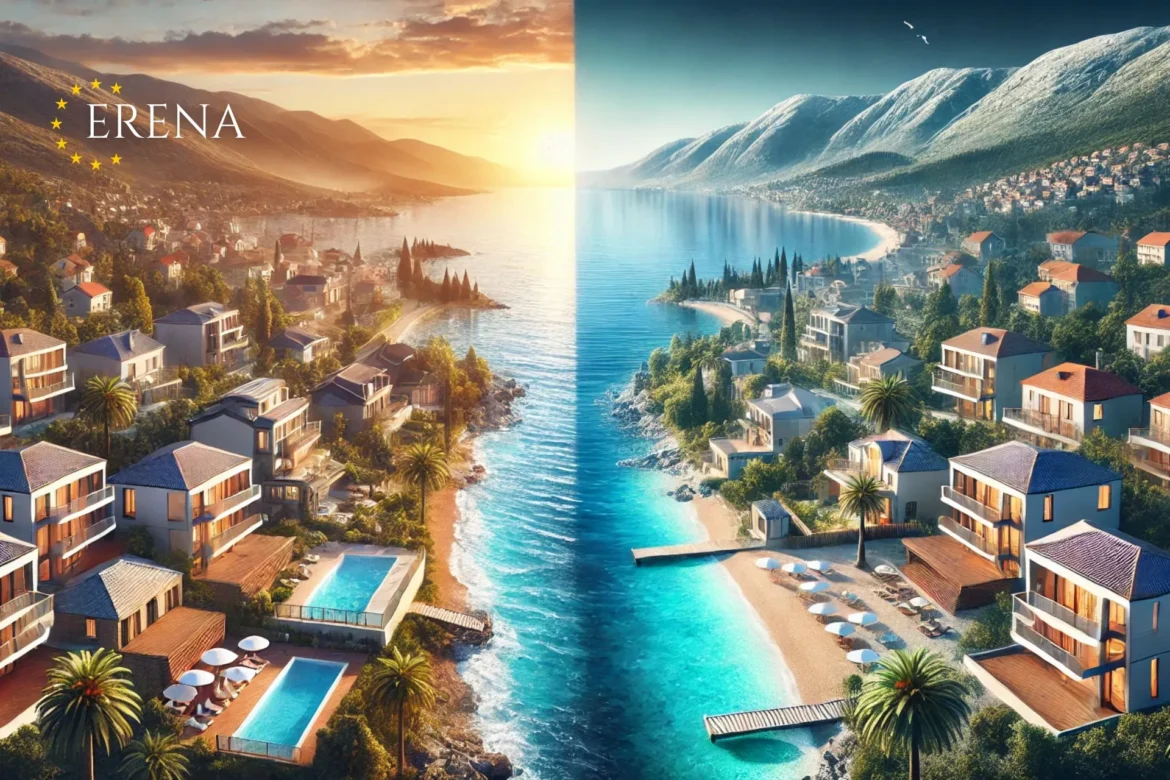Croatia and Montenegro are two popular destinations for investing in vacation real estate on the Adriatic coast. Both countries offer stunning beaches, well-developed infrastructure, and a growing flow of tourists. However, real estate investments in these countries differ in terms of price, profitability, taxes, and legal aspects. In this article, we compare where it is more beneficial to buy vacation real estate in 2024-2025 and examine average prices and potential returns.
1. Real Estate Market in Croatia
Prices and Trends
Croatia has been part of the European Union since 2013, which has increased its investment attractiveness. In recent years, the real estate market has shown stable growth due to increased tourism and infrastructure improvements.
Average real estate prices in popular regions (2024):
- Dubrovnik: €5,000 – €7,000/m²
- Split: €3,500 – €5,000/m²
- Zadar: €2,500 – €3,800/m²
- Istria: €2,500 – €4,500/m²
Trends:
- High demand for coastal properties.
- Price growth of 5-7% per year.
- The introduction of the euro in 2023 has stabilized the market.
Profitability and Rental Income
Vacation real estate in Croatia is in high demand among tourists. On average, short-term rental yields range from 5-8% per year.
Average rental prices during peak season:
- Apartment in Dubrovnik (50 m²) – €150-250 per night.
- Villa in Istria (200 m²) – €400-800 per night.
Taxes and Expenses
- Property purchase tax: 3%.
- Rental income tax: 10-15%.
- Annual property tax: 0.1% to 1%.
2. Real Estate Market in Montenegro
Prices and Trends
Montenegro is one of the fastest-growing real estate markets in the Balkans, attracting investors due to low taxes and a flexible residency-by-investment program.
Average real estate prices (2024):
- Budva: €2,800 – €4,500/m²
- Kotor: €2,500 – €4,000/m²
- Tivat: €3,000 – €5,500/m²
- Bar: €1,800 – €3,000/m²
Trends:
- Active development of luxury real estate.
- Price growth of 7-10% per year.
- High demand from foreign buyers.
Profitability and Rental Income
Vacation real estate in Montenegro is also in high demand, particularly in Budva, Kotor, and Tivat. Average short-term rental yields range from 6-10% per year.
Average rental prices during peak season:
- Apartment in Budva (50 m²) – €100-200 per night.
- Villa in Kotor (200 m²) – €300-700 per night.
Taxes and Expenses
- Property purchase tax: 3%.
- Rental income tax: 9%.
- Annual property tax: 0.1-1%.
3. Key Comparison of Investment Indicators
| Parameter | Croatia | Montenegro |
|---|---|---|
| Average real estate price | €2,500 – €7,000/m² | €1,800 – €5,500/m² |
| Annual price growth | 5-7% | 7-10% |
| Rental yield | 5-8% | 6-10% |
| Property purchase tax | 3% | 3% |
| Rental income tax | 10-15% | 9% |
| Annual property tax | 0.1-1% | 0.1-1% |
| Residency option | No | Yes (for investments over €250,000) |
4. Where Is It More Profitable to Invest?
Advantages of Croatia:
- EU membership – a stable market with investor protection.
- High liquidity – easier to sell property.
- Popular tourist destination – steady rental demand.
Advantages of Montenegro:
- More affordable prices – high-quality properties at lower costs.
- Higher rental yields – better rental profitability than in Croatia.
- Residency-by-investment – an option to obtain a residence permit.
Conclusion
The choice between Croatia and Montenegro depends on the investor’s priorities:
- If stability, liquidity, and EU membership are important, Croatia is the safer choice.
- If high rental yields and the possibility of residency are key factors, Montenegro is more attractive.
Both countries offer great investment opportunities, and the decision depends on the strategy and priorities of each individual investor.

